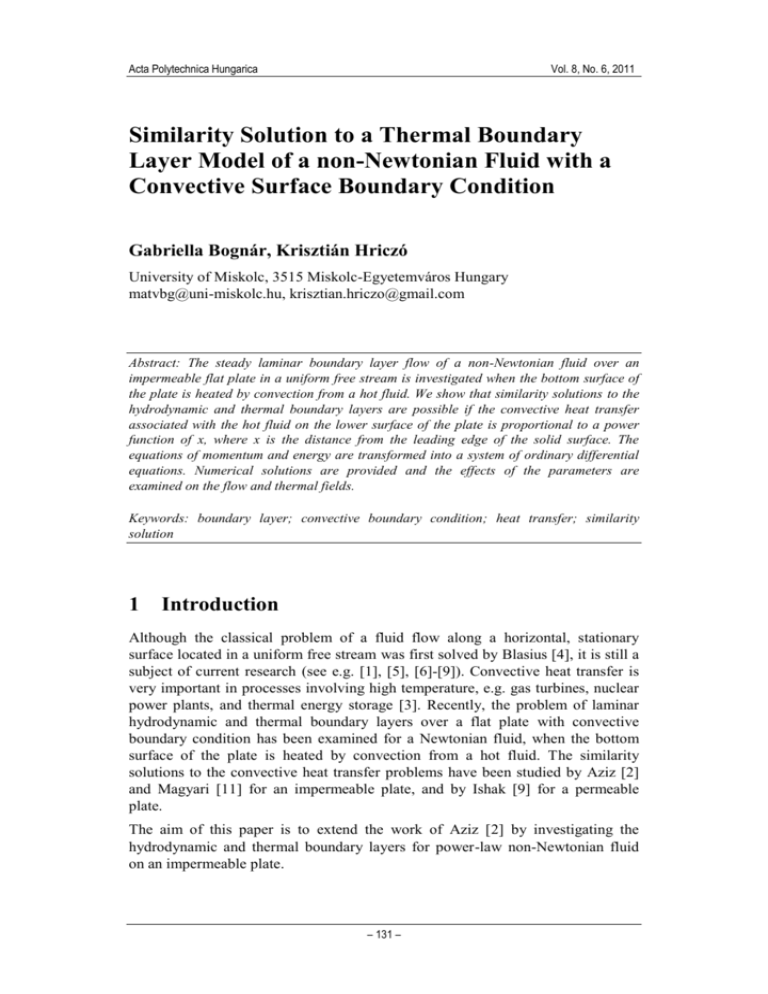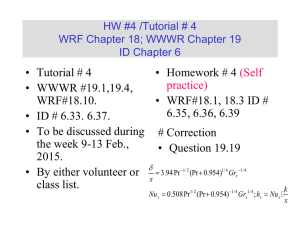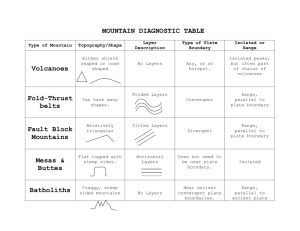Similarity Solution to a Thermal Boundary Layer Model of a non
advertisement

Acta Polytechnica Hungarica Vol. 8, No. 6, 2011 Similarity Solution to a Thermal Boundary Layer Model of a non-Newtonian Fluid with a Convective Surface Boundary Condition Gabriella Bognár, Krisztián Hriczó University of Miskolc, 3515 Miskolc-Egyetemváros Hungary matvbg@uni-miskolc.hu, krisztian.hriczo@gmail.com Abstract: The steady laminar boundary layer flow of a non-Newtonian fluid over an impermeable flat plate in a uniform free stream is investigated when the bottom surface of the plate is heated by convection from a hot fluid. We show that similarity solutions to the hydrodynamic and thermal boundary layers are possible if the convective heat transfer associated with the hot fluid on the lower surface of the plate is proportional to a power function of x, where x is the distance from the leading edge of the solid surface. The equations of momentum and energy are transformed into a system of ordinary differential equations. Numerical solutions are provided and the effects of the parameters are examined on the flow and thermal fields. Keywords: boundary layer; convective boundary condition; heat transfer; similarity solution 1 Introduction Although the classical problem of a fluid flow along a horizontal, stationary surface located in a uniform free stream was first solved by Blasius [4], it is still a subject of current research (see e.g. [1], [5], [6]-[9]). Convective heat transfer is very important in processes involving high temperature, e.g. gas turbines, nuclear power plants, and thermal energy storage [3]. Recently, the problem of laminar hydrodynamic and thermal boundary layers over a flat plate with convective boundary condition has been examined for a Newtonian fluid, when the bottom surface of the plate is heated by convection from a hot fluid. The similarity solutions to the convective heat transfer problems have been studied by Aziz [2] and Magyari [11] for an impermeable plate, and by Ishak [9] for a permeable plate. The aim of this paper is to extend the work of Aziz [2] by investigating the hydrodynamic and thermal boundary layers for power-law non-Newtonian fluid on an impermeable plate. – 131 – G. Bognár et al. 2 Similarity Solution to a Thermal Boundary Layer Model of a non-Newtonian Fluid with a Convective Surface Boundary Condition Basic Equations We consider a steady two-dimensional laminar flow of a viscous, incompressible fluid of density and temperature T over the top surface of a semi-infinite horizontal impermeable stationary flat plate. We assume that the free stream moves on the top of the solid surface with a constant velocity U . It is assumed that the bottom surface of the plate is heated by convection from a hot fluid of temperature T f . Within the framework of the above-noted assumptions, the governing equations of motion and heat transfer for non-Newtonian flow neglecting pressure gradient and body forces can be described by the following equations [13]: u v 0, x y (1) u u u 1 xy , v x y y (2) u T T T t v x y y y (3) where u , v are the velocity components along x and y coordinates, respectively, T is the temperature of the fluid in the boundary layer. Furthermore, we apply power-law relation between the shear stress and the shear rate by u xy K y n 1 u u , where y y n 1 denotes the kinematic viscosity, K is the consistency index for non-Newtonian viscosity and t is the thermal diffusivity and K . Here, n is called the power-law index, that is pseudoplastic, becomes n 1 for n 1 for Newtonian, and n 1 for dilatant fluids. Then, (2) u u u u v x y y y n 1 u . y The applicable boundary conditions for the present model are i. on the plate surface y 0 (no slip, impermeable surface and convective surface heat flux) – 132 – Acta Polytechnica Hungarica Vol. 8, No. 6, 2011 u x,0 0 , (4) v x,0 0 , (5) k T h f ( T f Tw ) , y (6) where h f is the heat transfer coefficient, and k denotes the thermal conductivity; ii. matching with the free stream as y u x, U , (7) T x, T . (8) If Tw denotes the uniform temperature over the top surface of the plate we have the relations: T f Tw T . Introducing the following dimensionless variables b x f , y a , x w( x, y ) T T , T f T for some constants a, b, , , where is the stream function. For u v , y , the equation of continuity (1) is satisfied identically. On the other x hand, we have y yx x yy ( yy n1 yy ) y (9) and conditions (4), (5), (7) can be written as y ( x,0) 0 , x ( x ,0 ) 0 , y ( x, ) U . Applying similarity variable (10) we derive x b x 1[ f f ] , y a b x f , – 133 – (11) G. Bognár et al. Similarity Solution to a Thermal Boundary Layer Model of a non-Newtonian Fluid with a Convective Surface Boundary Condition where a prime denotes differentiation with respect to . By inserting (10) and (11) into (9) we get f n1 f f f f 2 0 (12) if 2 n 2n 1 1 and a 2n1b n2 1 . Taking boundary condition (7) we have a b U and 0 . In order to satisfy conditions in (10), for a, b, , one gets 1 , n 1 a 1 n 1 U 2 n n 1 b , 1 n 1 U 2n 1 n 1 and 1 n 1 ( x, y ) U 2n 1 1 n 1 n 1 x f ( ) , 1 n 1 U 2n n 1 y 1 n x 1 . Equation (12) with the transformed boundary conditions has the form f n1 f 1 f f 0 , n 1 f 0 0 , f 0 0 , (13) f lim f 1 . (14) The dimensionless velocity components have the form u( x, y) U f ( ) , 1 U n 1 v( x , y ) Rex ( f ( ) f ( )) , n 1 1 n 1 y and Re x x , where Re x U 2n x n is the local Reynolds number. n 1 u The thermal diffusivity can be defined as t for u 0 ( positive y constant) and t 0 for u 0 (see [13]). Hence, from equation (3) – 134 – Acta Polytechnica Hungarica u Vol. 8, No. 6, 2011 n 1 w w u w , v x y y y y Defining the non-dimensional temperature (15) by ( ) w( x, y) , i.e. T T ( )( T f T ) we get f ( ) n1 ( ) Pr f ( )( ) 0 , n 1 where Pr (16) is the Prandtl number. The transformed boundary conditions for the energy equation (16) ( 0 ) 2n U 1 n 1 h f ( x ) 1 0 x k c and substituting a 2n k U 1 n 1 one can obtain (0) a (1 (0)) (17) 1 /( n 1 ) under the assumption that the heat transfer coefficient h f cx . We note that for Newtonian fluids it was shown in [2], [3], [9] that similarity solutions 1 / 2 exist if h f is proportional to x . For a uniform surface temperature (0) 1 holds and from (17) ' (0) 0 . This adiabatic case has been analysed by Magyari [10] for Newtonian fluid. Boundary condition (8) can be formulated () lim 0 . (18) According to our knowledge there is no exact solution; therefore one has to use a numerical technique to solve the boundary value problems for the similarity equations (13), (14), (16), (17), (18). – 135 – G. Bognár et al. 3 Similarity Solution to a Thermal Boundary Layer Model of a non-Newtonian Fluid with a Convective Surface Boundary Condition Results The nonlinear ordinary differential equation (13) subject to the boundary conditions in (14) were solved numerically using the symbolic algebra software Maple 12. The boundary value problem has been solved by the Runge-KuttaFelhberg fourth-fifth method. Fig. 1 shows the Maple generated numerical solution for the velocity profiles for different values of n. Figure 1 The profiles of f ' ( ) u( x , y ) / U for different values of n For fixed Prandtl numbers 0.72 and 10, for selected values of the power index n , for a range of parameters a Table 1 and Table 2 provide the numerical data for ' (0) and (0) , respectively. In the case of n =1, the numerical values show a good agreement with those reported by Aziz [2] and Ishak [8]. Figures 2-4 exhibit that the plate surface temperature decreases as either Pr or n increases and also when a decreases. The temperature gradient at the surface increases as Pr increases, which implies an increase in the heat transfer rate at the surface. We observe that the thermal boundary layer thickness decreases with an increasing Prandtl number or increasing power index n ; moreover, the hydrodynamic boundary layer thickness decreases as n increases. – 136 – Acta Polytechnica Hungarica Vol. 8, No. 6, 2011 Values of a n = 0.5 Pr = 0.72 0.05 0.10 0.20 0.40 0.60 0.80 1 5 10 20 0.043392 0.076655 0.124294 0.180329 0.212221 0.232808 0.247195 0.308129 0.317925 0.323061 (0) Table 1 for various values of Pr = 10 n=1 Pr = 0.72 0.046625 0.087355 0.155101 0.253329 0.321120 0.370723 0.408591 0.607006 0.646233 0.667811 0.042767 0.074724 0.119295 0.169994 0.198051 0.215864 0.228178 0.279131 0.287146 0.291328 a , Pr and n Pr = 10 n = 1.5 Pr = 0.72 Pr = 10 0.046787 0.087925 0.156903 0.258174 0.328945 0.381191 0.421344 0.635583 0.678721 0.702563 0.043390 0.076647 0.124273 0.180285 0.212159 0.232732 0.247110 0.307997 0.317784 0.322915 0.047138 0.089174 0.160928 0.269255 0.347148 0.405853 0.451682 0.707239 0.761065 0.791172 Figure 2 Temperature profiles for different values of Pr when n=0.5 and – 137 – a =1 G. Bognár et al. Similarity Solution to a Thermal Boundary Layer Model of a non-Newtonian Fluid with a Convective Surface Boundary Condition Figure 3 Temperature profiles for different values of n when Pr=10and Figure 4 Temperature profiles for different values of – 138 – a =1 a when Pr=0.72 and n=0.5 Acta Polytechnica Hungarica Vol. 8, No. 6, 2011 Values of a n = 0.5 Pr = 0.72 0.05 0.10 0.20 0.40 0.60 0.80 1 5 10 20 0.132148 0.233446 0.378526 0.549175 0.646298 0.708990 0.752805 0.938374 0.968207 0.983847 (0) Table 2 for various values of Pr = 10 n=1 Pr = 0.72 0.067487 0.126441 0.224497 0.366677 0.464799 0.536596 0.591408 0.878599 0.935377 0.966609 0.144661 0.252758 0.403523 0.575014 0.669916 0.730170 0.771822 0.944173 0.971285 0.985434 a , Pr and n Pr = 10 n = 1.5 Pr = 0.72 Pr = 10 0.064256 0.120752 0.215484 0.354566 0.451759 0.523512 0.578656 0.872883 0.932128 0.964872 0.132200 0.233528 0.378634 0.549289 0.646402 0.709085 0.752890 0.938401 0.968222 0.983854 0.057224 0.108253 0.195359 0.326862 0.421420 0.492684 0.548318 0.858552 0.923894 0.960441 Conclusions In this paper we studied the problem of steady laminar boundary layer flow and heat transfer over a stationary flat surface in a parallel stream with convective boundary condition. Similarity solution to the thermal field is possible when the convective heat transfer from the lower surface varies like x 1/(n1) , where x is the distance from the plate. On the flow and thermal fields, the influence of the governing parameters, the Prandtl number, the power index n and the value of a characterizing the hot fluid convection process is discussed. Acknowledgement This research was carried out as part of the TAMOP-4.2.1.B-10/2/KONV-20100001 project with support by the European Union, co-financed by the European Social Fund. References [1] Ahmad F., Al-Barakati W. H.: An approximate Analytic Solution of the Blasius Problem, Comm. Nonlinear Sci. Num. Simul., 14 (2009), pp. 10211024 [2] Aziz A.: A Similarity Solution for Laminar Thermal Boundary Layer over a Flat Plate with a Convective Surface Boundary Condition, Comm. Nonlinear Sci. Numer. Simulat. 14 (2009), pp. 1064-1068 [3] Bataller R. C.: Radiation Effects for the Blasius and Sakiadis flows with a Convective Surface Boundary Condition, Appl. Math. Comput. 206 (2008), pp. 832-840 – 139 – G. Bognár et al. Similarity Solution to a Thermal Boundary Layer Model of a non-Newtonian Fluid with a Convective Surface Boundary Condition [4] Blasius H.: Grenzschichten in Flussigkeiten mit kleiner reibung, Z. Math. Phys., 56 (1908), pp. 1-37 [5] Cortell R.: Numerical Solutions of the Classical Blasius Flat-Plate Problem, Appl. Math. Comput., 170 (2005), pp. 706–710 [6] Dénes J, Patkó I.: Computation of Boundary Layers, Acta Polytechnica Hungarica, 1 (2004), pp. 79-87 [7] He J. H.: A Simple Perturbation Approach to Blasius Equation, Appl. Math. Comput., 140 (2003), pp. 217-222 [8] He J. H.: Approximate Analytical Solution of Blasius Equation, Comm. Nonlinear Sci. Num. Simul., 3 (1998), pp. 260-263 [9] Ishak A.: Similarity Solution for Flow and Heat Transfer over a Permeable Surface with Convective Boundary Condition, Appl. Math. Comput. 217 (2010), pp. 837-842 [10] Liao S. J.: An Explicit, Totally Analytic Approximate Solution for Blasius Viscous Flow Problems, Int. J. Non-Linear Mech., 34 (1999), pp. 759-778 [11] Magyari E.:, The Moving Plate Thermometer, Int. J. Therm. Sci., 47 (2008), pp. 1436-1441 [12] Magyari E.: Comment on “A Similarity Solution for Laminar Thermal Boundary Layer Over a Flat Plate with a Convective Surface Boundary Condition” by A. Aziz, Comm. Nonlinear Sci. Numer. Simul. 2009; 14:1064-8, Comm. Nonlinear Sci. Numer. Simulat. 16 (2011), pp. 599-601 [13] Zheng L., Zhang X., He J.: Suitable Heat Transfer Model for Self-Similar Laminar Boundary Layer in Power Law Fluids, J. Thermal Science 13 (2004), pp. 150-154 – 140 –








